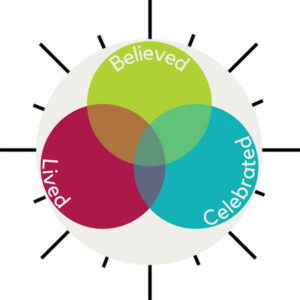By Ella Johnson
Eucharistic Revival Column
When my husband, Gerry, and I were dating and began to spend more and more time together, we eventually introduced each other to our routine Sunday activities. He began joining me at Mass and I began joining him at his family’s “Sunday lunch.” In doing so, I learned that his mother, who grew up in Italy, is a wonderful cook and I would never go hungry around her.

In fact, “Sunday lunch” often entailed five courses! I always returned home with leftovers that fed me for the next couple of days. Gerry learned of my interest in the Mass and began to make his own observations. I remember one comment he made after Mass, in particular: “It’s all about a meal!” I chuckled at first, because the insight seemed so natural coming from someone whose family appreciates the importance of a good weekly meal. But, as I thought about his comment further, I realized how profound it was in its simplicity.
In the Gospel of Luke, for instance, significant acts in Jesus’ life and ministry center around meals. Robert Karris notes how shepherds find the infant Jesus laying in a manger — literally a “feed box” — in Luke 2:12. The kingdom parables of the lost coin, the lost sheep and the prodigal son are connected by their shared context of Jesus sharing a meal with “tax collectors and sinners” (15:1-3). The disciples at Emmaus recognize the resurrected Jesus only after he breaks bread with them (24:13-35). Taken together, these accounts illustrate that table fellowship is a central way in which Christians participate in Christ’s life, death and resurrection.
Of course, dining together is important (and not just to my mother-in-law)! It signifies nourishment and life, intimate relationship and bondedness. As Kevin Irwin points out, for Jews, an invitation to a Sabbath meal and especially a Passover meal means to be considered “one of the family.” This is why Judas’ betrayal of Jesus at the Last Supper was so heartbreaking. As a close follower of Jesus and companion (literally meaning “with bread” or to break bread with), Judas betrayed Jesus in a deeply intimate setting. At the same time, the Last Supper is the place in which Jesus overturns all betrayal and establishes reconciliation between God and humankind once more.
 Every time we share the Lord’s Supper, we have the opportunity to participate in a sacred meal with Christ and in his paschal dying and rising. Prompting us to recognize this opportunity, we hear several important references to the Lord’s “Supper” in the Mass, especially in the eucharistic prayers. Before the words over the cup, in the Roman Canon, in addition to the second and third eucharistic prayers, we hear the words, “when supper was ended.” Before the words over both the bread and cup, in the fourth eucharistic prayer, we hear declared “while they were at supper.” The separation between what is declared over the bread and cup in the Roman Canon and the second and third eucharistic prayers reflects the structure of the Passover meal. As Irwin points out, the sharing of the (seder) meal itself happens between these two declarations. The declaration, “this is the chalice/cup of my blood,” occurs as the third cup of wine is taken at the Passover. It is the moment in the meal when God’s covenant relationship is recalled. In Christian context, this phrase solemnly declares the new covenant in Jesus.
Every time we share the Lord’s Supper, we have the opportunity to participate in a sacred meal with Christ and in his paschal dying and rising. Prompting us to recognize this opportunity, we hear several important references to the Lord’s “Supper” in the Mass, especially in the eucharistic prayers. Before the words over the cup, in the Roman Canon, in addition to the second and third eucharistic prayers, we hear the words, “when supper was ended.” Before the words over both the bread and cup, in the fourth eucharistic prayer, we hear declared “while they were at supper.” The separation between what is declared over the bread and cup in the Roman Canon and the second and third eucharistic prayers reflects the structure of the Passover meal. As Irwin points out, the sharing of the (seder) meal itself happens between these two declarations. The declaration, “this is the chalice/cup of my blood,” occurs as the third cup of wine is taken at the Passover. It is the moment in the meal when God’s covenant relationship is recalled. In Christian context, this phrase solemnly declares the new covenant in Jesus.
In fact, all of the institution narratives (in Paul, Matthew, Mark and Luke) refer to this moment when Jesus takes the cup. The cup is important because it contains the blood of Christ, which is shed for us and offered as something in which we can participate. In other words, we share in Christ’s self-offering, through the act of dining, when we share together the one eucharistic bread and cup.
In some sense, then, the Mass really is “all about a meal.” It is through eating and drinking that we ratify our commitment to God and each other. While there are many important symbols in our celebration of the Eucharist, the supper-meal context is foundational. Our celebration of the Mass derives from what Jesus was doing “at supper,” in the context of the Jewish Sabbath meal and the Passover Seder. The human action of eating a meal together provides a rich theological and liturgical context for us to more deeply understand what takes place in our eucharistic Communion.
(Ella Johnson, PhD, is an associate professor in the theology department of St. Ambrose University in Davenport.)











